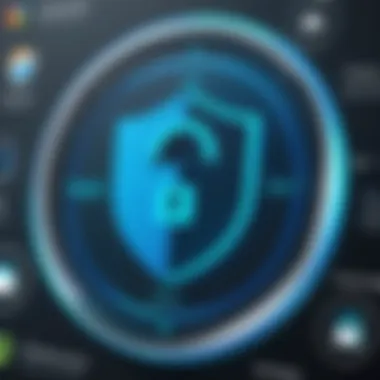Enhance Your Security: Microsoft Authenticator with Chrome


Intro
In today's digital landscape, securing online accounts is paramount. The rise of data breaches and identity theft underscores the importance of robust authentication processes. Utilizing Microsoft Authenticator with Chrome embodies a practical approach to enhance security through two-factor authentication (2FA). This guide will help users understand the integration process, its benefits, and troubleshooting strategies while maintaining optimal safety practices.
Product Overview
Key Features
Integrating Microsoft Authenticator with Chrome presents several compelling features. First, it offers convenience with a streamlined login experience. Users can quickly verify their identity via push notifications or authentication codes. Next, it provides a high level of security through the generation of time-based one-time passwords (TOTP). Additionally, the app supports multiple accounts, making it easy to manage different logins in one place.
Specifications
Microsoft Authenticator operates on both iOS and Android platforms, ensuring wide accessibility. The app's compatibility with Chrome extends across multiple devices, enabling seamless synchronization of authentication methods. It also features backup options, safeguarding user data against device loss or damage. Overall, users benefit from a user-friendly interface, complemented by strong security measures that protect their online presence.
Setting Up Microsoft Authenticator with Chrome
Step-by-Step Installation
- Download the App: Find Microsoft Authenticator in the Google Play Store or Apple App Store. Install the app on your smartphone.
- Add Account: Open the app, select the option to add an account, and choose Microsoft Account or Other accounts depending on your requirement.
- Open Chrome: Launch the Chrome browser on your computer.
- Access Settings: Navigate to the settings menu by clicking on the three dots in the upper right corner and selecting Settings.
- Enable 2-Step Verification: Locate the Security section and turn on 2-Step Verification. Follow the prompts to link your Microsoft Authenticator.
- Scan QR Code: Using your phone, scan the QR code displayed in Chrome. This links your account to the Authenticator app.
- Confirm: Enter the verification code generated by the app to confirm successful integration.
Benefits of Using Microsoft Authenticator with Chrome
Utilizing Microsoft Authenticator with Chrome yields several advantages. Here are some important points:
- Enhanced Security: Two-factor authentication adds a strong layer of protection against unauthorized access.
- Convenient Login: Quick access to accounts without the need for password entry each time streamlines the experience.
- Cross-Device Syncing: Users can easily switch between devices without losing access to their credentials.
"Employing Microsoft Authenticator alongside Chrome significantly reduces the risk of account compromise, offering peace of mind in an increasingly vulnerable online environment."
Potential Troubleshooting Scenarios
Users may encounter issues when using Microsoft Authenticator with Chrome. Here are common problems and solutions:
- App Not Syncing: Ensure that both the app and Chrome are updated to the latest versions.
- Verification Code Not Accepted: Double-check the code entered; time discrepancies may lead to failures. Resynchronize if needed.
- Lost Access to App: Use the backup codes provided during the setup process to regain access during emergencies.
Best Practices for Maintaining Security
To maximize the security offered by Microsoft Authenticator, consider these best practices:
- Regularly review account security settings.
- Enable notifications for suspicious activity.
- Keep the app updated to benefit from the latest security features.
In summary, integrating Microsoft Authenticator with Chrome is a strategic move towards better online security. This guide consolidates essential steps, anticipates challenges, and promotes practices that ensure a strong defense against potential threats.
Prelims to Microsoft Authenticator App
The rise of digital insecurity has prompted many users and organizations to adopt stronger security measures for their online accounts. The Microsoft Authenticator App plays a crucial role in this landscape by facilitating two-factor authentication. Understanding this app not only helps individual users protect their data but also aids businesses in safeguarding sensitive information. This article aims to illustrate how the Microsoft Authenticator App integrates with the Chrome browser, enhancing the ability to maintain security in everyday digital interactions.
Overview of Two-Factor Authentication
Two-factor authentication, commonly referred to as 2FA, is a security process that requires users to verify their identity through two different forms of identification before accessing an account. This method serves as an additional layer of security beyond just a username and password. With 2FA enabled, even if a password is compromised, unauthorized access can still be prevented.
The first factor is typically the user's password. The second factor can take many forms, including something the user possesses, such as a smartphone or a hardware token. In the case of the Microsoft Authenticator App, it generates time-sensitive codes that the users must input during the login process.


Significance of Authentication Apps
Authentication apps, like Microsoft Authenticator, offer a secure method to manage two-factor authentication. These apps generate unique codes that are required for logging into accounts, significantly decreasing the chances of account forgery. They are user-friendly, and most importantly, they simplify the process of access verification.
The significance of using authentication apps lies in their convenience and effectiveness. For tech-savvy individuals and organizations, they provide not just a means of logging in, but also a way to maintain peace of mind. Moreover, these apps are typically independent of mobile service providers and can be used offline once installed, making them reliable for users in various situations.
"Two-factor authentication is a fundamental part of any security strategy. The use of applications like Microsoft Authenticator takes it a step further, ensuring that accounts are protected even in the event of a password breach."
Understanding Chrome Browser Compatibility
The integration of the Microsoft Authenticator app with Google Chrome has become a pivotal aspect for users seeking enhanced security in their online experience. Understanding how Chrome interacts with authentication apps, particularly Microsoft Authenticator, is essential for optimizing security protocols. This section delves into the supported features and limitations within Chrome that may affect your usage of the Authenticator app.
Supported Features within Chrome
Chrome offers a variety of features that facilitate the effective use of Microsoft Authenticator for two-factor authentication. Some of the key features include:
- Seamless Integration: Chrome allows users to easily link their Microsoft accounts with the Authenticator app. Once set up, logging in becomes more secure without complicated processes.
- Push Notifications: When logging into websites, Chrome can send push notifications to the Authenticator app. This simplifies the approval process, allowing users to authenticate quickly and efficiently.
- Password Autocomplete: The compatibility extends to password management features. Users can store and retrieve their passwords with ease, further integrating the use of the Authenticator app for enhanced security.
- Cross-Platform Usage: With Google Chrome available on various operating systems, users can maintain a consistent authentication experience across devices. This includes laptops, tablets, and smartphones.
These features empower users to exploit the full potential of Microsoft Authenticator while utilizing Chrome, making the login experience safer and more straightforward.
Limitations to Consider
While there are notable advantages, it is crucial to acknowledge the limitations regarding Chrome's compatibility with the Authenticator app. Some key considerations include:
- Browser-Specific Features: Not all features available in other browsers may be present in Chrome. Users might miss out on certain optimizations offered by different platforms.
- Limited Offline Functionality: While the app itself can generate codes offline, Chrome may require an internet connection for certain authentication processes. This can be a drawback for users in low-connectivity situations.
- Interference from Extensions: Some Chrome extensions can interfere with the operation of the Authenticator app. This includes ad-blockers or privacy tools that may disrupt data flow.
- Privacy Concerns: Users should be cautious about the information shared between Chrome and the Authenticator app. A lack of understanding about data use can lead to privacy vulnerabilities.
Recognizing these limitations helps users make informed decisions about their security practices while leveraging Microsoft Authenticator with Chrome.
"Understanding the compatibility between Chrome and Microsoft Authenticator is as crucial as the use of the technology itself. It ensures users maximize security while minimizing potential risks."
In summary, comprehending the landscape of features and limitations within Chrome not only enhances user experience but also lays the groundwork for a more secure online environment.
Setting Up Microsoft Authenticator
Setting up Microsoft Authenticator is a foundational step for achieving enhanced online security. This section will detail the process and its importance. By implementing Microsoft Authenticator, users can significantly reduce the risk of unauthorized access to their accounts. The strength of two-factor authentication lies in its ability to add an additional layer of security beyond just a password. With malware and phishing attacks on the rise, the need for robust security measures is clear. Therefore, setting up Microsoft Authenticator not only fortifies the user's defenses but also contributes to a broader culture of digital security.
Initial Installation Process
To begin, users need to download the Microsoft Authenticator app from their device's application store. The app is available for both iOS and Android devices. Once installed, the app will require permission to access the device's camera and notifications, features essential for its functionality. Users should take a moment to familiarize themselves with the interface upon opening the app for the first time. The layout is simple, guiding users toward linking their accounts easily. After granting necessary permissions, proceed to the next step of creating an account or linking an existing one, which is crucial for utilizing the app's full potential.
Creating an Account
Creating an account in the Microsoft Authenticator app is straightforward. Users can log in using their Microsoft account, or create a new account if they do not have one. This step is essential, as the app synchronizes authentication codes with the user’s Microsoft account. For those who prioritize privacy, the app supports securing multiple accounts within a single interface. After logging in, the user is prompted to add accounts that will utilize two-factor authentication. This process often involves scanning a QR code or inputting a secret key provided during the account setup process on the respective service's platform.
Enabling Two-Factor Authentication
Enabling two-factor authentication is the critical finale of the setup process. Users should navigate to the security settings of their online accounts to turn on two-factor authentication. This section typically provides options for authentication methods. Users will select the option to use an authentication app, which will often display a QR code. By scanning this code with Microsoft Authenticator, users complete the integration. The app will then start generating time-sensitive codes needed for verification during future logins. It is advisable for users to save backup codes provided during this setup, as they serve as a fail-safe should they lose access to the app or their device.
"Two-factor authentication is not just an option; it is a necessity in today's digital landscape."
Integrating Microsoft Authenticator with Chrome


Integrating the Microsoft Authenticator app with the Chrome browser is a pivotal step in enhancing your online security. By enabling this integration, user can leverage the advanced two-factor authentication feature to better protect their accounts against unauthorized access. This section will highlight essential elements and benefits of linking your Microsoft Authenticator with Chrome, as well as considerations that may arise during the process.
Linking Account to Authenticator App
To link your account to the Microsoft Authenticator app, you first need to access your desired online service on Chrome. Whether it is a social media account or a financial service, many platforms support two-factor authentication. Search for the two-factor authentication settings within the security or account settings of the service you are using.
- Access Security Settings - Locate the security or account settings page in the platform’s web interface.
- Select Two-Factor Authentication - Choose the option to enable two-factor authentication or similar wording.
- Choose Authenticator App - When prompted, select the Microsoft Authenticator app as your method of authentication.
- Scan QR Code - The platform will display a QR code. Open the Authenticator app and select the option to add a new account. This usually involves tapping a plus (+) icon or an "Add Account" button. Then scan the QR code displayed on your screen.
After successfully linking, you should see a verification code generated by the Authenticator app. If all steps are completed correctly, the account should now be linked, enhancing your security.
Using Authenticator for Login Authentication
Once your account is linked, the Microsoft Authenticator app becomes your main tool for login authentication. Each time you attempt to log in, the Authenticator app generates a unique one-time code. This code is time-sensitive and changes typically every 30 seconds. The need for the code further secures your login process and protects against unauthorized access.
To use the Authenticator for logging in:
- Enter Your Credentials - Go to the login page of the website or service and input your username and password as usual.
- Retrieve the Code - Once you are prompted for the two-factor authentication code, open the Microsoft Authenticator app. Look for the entry corresponding to the service you are trying to access; this should display the current verification code.
- Input the Code - Enter the verification code from the app into the provided field on the service’s login page. If the code is correct, you will be granted access.
This method not only boosts security but also provides peace of mind when handling sensitive information online.
Overall, integrating Microsoft Authenticator with Chrome significantly elevates your account security. It minimizes the risk of hacking and unauthorized access, which is increasingly crucial in our digital age. As cyber threats continue to grow in sophistication, it becomes essential to employ robust security measures like this.
Advantages of Using Microsoft Authenticator
The Microsoft Authenticator app offers multiple advantages that contribute to enhanced digital security, especially when integrated with the Chrome browser. This section outlines key benefits of using the app, focusing on its effectiveness in protecting accounts, its ease of use, and its capacity for accessibility across various devices. Understanding these aspects is crucial for users who are keen on implementing two-factor authentication in their online activities.
Enhanced Security for Accounts
One of the most significant benefits of the Microsoft Authenticator app is the heightened security it provides for user accounts. Two-factor authentication (2FA) is an essential feature that significantly reduces the risk of unauthorized access. The app generates time-sensitive codes, which adds an extra layer of protection beyond just passwords. If a password is compromised, the likelihood of being hacked is greatly diminished as the attacker would also need the code from the Authenticator app.
Moreover, utilizing the app aids in protecting sensitive information. By relying on an app that generates codes offline, users reduce exposure to phishing attacks and ensure that even if a hacker has the password, access still requires the second factor. This dual-layer security framework is particularly effective against techniques like credential stuffing, where attackers use leaked passwords from one site to try accessing other accounts.
Ease of Use with Chrome
Integrating Microsoft Authenticator with Chrome simplifies the authentication process. The app is designed with a user-friendly interface, making it accessible for both tech-savvy individuals and those less familiar with technology. When logging in to websites, users can easily choose to receive a code through the Authenticator app. This process is generally quicker than waiting for an email or text message.
The seamless integration also means that users do not have to switch between apps frequently. Once setup is complete, the process feels intuitive. Users can simply click the prompt in Chrome to authenticate and log in with just one additional step. It streamlines the login experience without sacrificing security, maintaining a balance that is critical for everyday internet use.
Accessibility across Devices
Another advantage of using the Microsoft Authenticator app is its accessibility across devices. The app is available for both Android and iOS, allowing users to install it on multiple devices. This flexibility means that users can access their authentication codes whether they are on their smartphone, tablet, or even when they have to use a different device temporarily.
By backing up account information in the cloud, users can recover their authentication methods even if they lose their primary device. This backup capability ensures that they remain in control of their accounts. However, it is essential to maintain a secure method of accessing the backup, as this could be a potential risk if not adequately protected. In essence, the Microsoft Authenticator app not only enhances security but also provides an accessible and convenient method for managing security across all devices.
Common Issues and Troubleshooting
Understanding common issues and troubleshooting techniques related to the Microsoft Authenticator app when used with Chrome is essential for maintaining seamless online security. Even though the app is designed for user-friendliness and efficiency, users might encounter obstacles that hinder the authentication process. Addressing these issues promptly can enhance security protocols and restore ease of access.
Trouble Linking Accounts
Linking your Microsoft Authenticator with your Chrome account is a straightforward process but can occasionally lead to hiccups. One common problem is misconfigured settings that prevent successful linking. Ensure that both the app and browser are updated to their latest versions, as older versions may lack compatibility features.


Here are few tips to resolve linking troubles:
- Check Internet Connection: A weak connection can prevent proper linking. Make sure your device is connected to a stable network.
- Reinstall the App: If persistent issues occur, uninstalling and reinstalling the Authenticator app often resolves underlying problems.
- Review Permissions: Ensure that the app has the necessary permissions to operate properly. On mobile devices, this could involve adjusting security settings.
Authenticator Not Generating Codes
If the Microsoft Authenticator app stops generating codes, it can be a significant setback for secure logins. Often, this issue arises from the inaccurate time settings on your device, which can lead to incorrect code generation. Both the app and the account you are trying to access must be synchronized.
To fix this problem, follow these steps:
- Sync Time Settings: Adjust your device's time settings to automatic to ensure time synchronization. On most devices, this can be found in the date and time settings.
- Restart the App: Sometimes, simply closing and reopening the app refreshes its functionality.
- Update the App: Keeping the app updated minimizes bugs. Check for updates in your device's application store.
Consider verifying the codes generated by the Authenticator with an alternate method of verification when in doubt.
Lost Access to Authenticator App
Losing access to the Microsoft Authenticator app can be concerning, especially when it results in inaccessibility to various accounts. When faced with this situation, users must act swiftly to regain control.
In such cases, here are the suggested approaches:
- Recovery Options: If the app has been backed up, recovering it is usually a straightforward process. Most modern apps offer cloud-based recovery.
- Backup Codes: When enabling two-factor authentication, many services provide backup codes. These codes can be valuable in case of losing access.
- Contact Support: If all else fails, reaching out to the support team of the specific service can provide additional methods to regain access. They may require verification of identity, so be prepared to provide necessary information.
Maintaining redundancy in authentication methods increases security resilience. Always keep backup options available for critical accounts.
Best Practices for Digital Security
Maintaining robust digital security is essential in today’s interconnected world. With the increasing frequency of cyber threats, employing best practices is not just advisable, but necessary. Best Practices for Digital Security ensures that users can effectively safeguard their personal and sensitive information across various platforms. Knowing how to defend yourself online can often mean the difference between a secured account and an easily compromised one. This guide delves into the most effective strategies to improve personal digital security, particularly in relation to the Microsoft Authenticator app and Chrome Browser.
Regular Updates of Apps and Passwords
Keeping apps and passwords updated is crucial for maintaining security. Software updates often contain patches for vulnerabilities that cybercriminals could exploit. Ignoring these updates increases the risk of unauthorized access. It’s advisable to enable automatic updates for both the Microsoft Authenticator app and your Chrome browser whenever possible. Avoid using default passwords; instead, choose strong, unique passwords. One should change their passwords regularly as an added layer of protection, minimizing the risk from a potential data breach.
Using Unique Passwords across Services
The practice of using unique passwords for each service is fundamental in minimizing the risk of compromise. If one service encounters a data breach, having unique passwords limits the ability of attackers to access multiple accounts. Utilizing a password manager can assist in managing and generating complex passwords without overburdening the user with remembering each individual password. It is recommended to create passwords that combine letters, numbers, and symbols, creating a stronger barrier against unauthorized access.
Monitoring Account Activity
Regularly monitoring account activity is another vital aspect of digital security. Users should actively review their account statements and login histories for any suspicious behavior. If something seems off, act promptly. Setting up alerts for any unusual activity can be beneficial. Both Microsoft Authenticator and Chrome allow notifications for login attempts, alerting you before any damage is done. Additionally, folders can be created for secure backup of accounts and activities, promoting ongoing vigilance.
"Digital security is not a one-time effort but a continuous process that requires awareness and regular actions to keep your data safe."
By implementing these practices, users can significantly reduce their risk of digital threats. Following these guidelines is not just a single endeavor but an ongoing commitment to security in the digital landscape.
The End and Future Implications
The conclusion of this guide sheds light on the critical role that Microsoft Authenticator and similar apps play in enhancing digital security. As cyber threats evolve, the methods to safeguard our personal and professional information must also advance. Therefore, understanding how to effectively integrate the Microsoft Authenticator app with the Chrome browser can significantly bolster security protocols for users.
Evolving Landscape of Online Security
Online security is not static; it changes rapidly in response to emerging threats. Years ago, the reliance on single-password systems was prevalent. However, as data breaches became more common, the need for two-factor authentication (2FA) gained recognition. Microsoft Authenticator exemplifies this shift. It not only provides an additional layer of security but also adapts to technological progression, including biometrics like fingerprint recognition. Users are now expected to be more proactive about their security. Engaging with tools like the Microsoft Authenticator app is no longer optional but necessary for maintaining control over one’s digital footprint.
"The future of security rests on adopting comprehensive solutions that anticipate threats before they materialize."
The Role of Authentication Apps in Future Security Protocols
Looking towards the future, authentication apps are set to become fundamental to security architectures everywhere. With increasing emphasis on privacy, users will need reliable systems that ensure their data is protected. Authentication apps like Microsoft Authenticator are likely to evolve, integrating features such as machine learning for anomaly detection, enhancing their capabilities in identifying unauthorized access attempts. These advancements can help inform users in real-time about potential security risks, thereby improving their immediate response capabilities.



